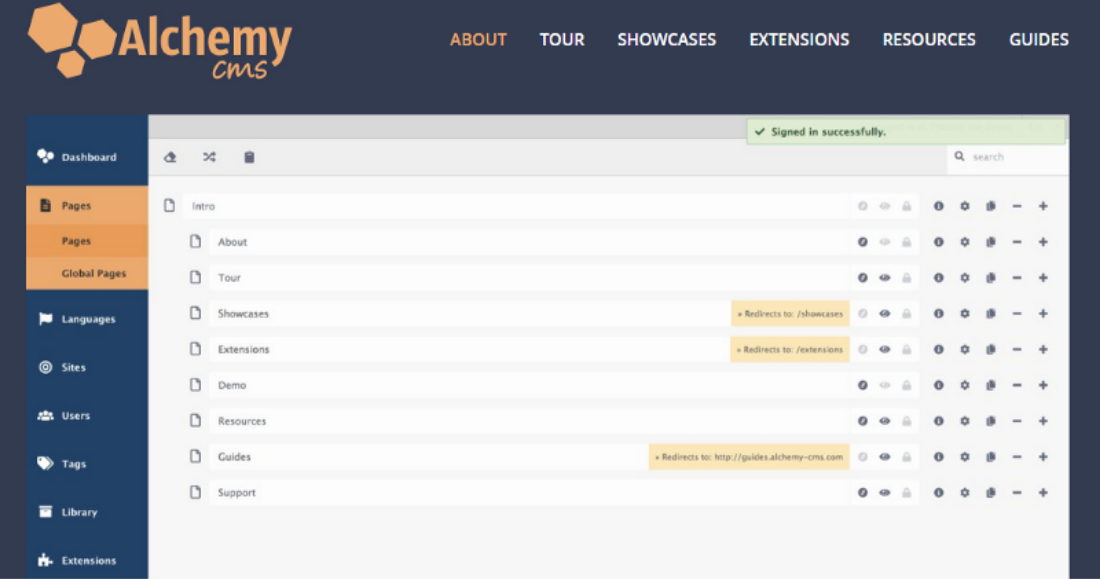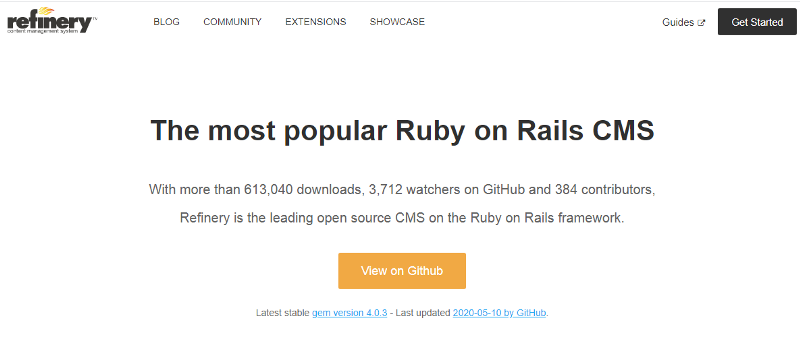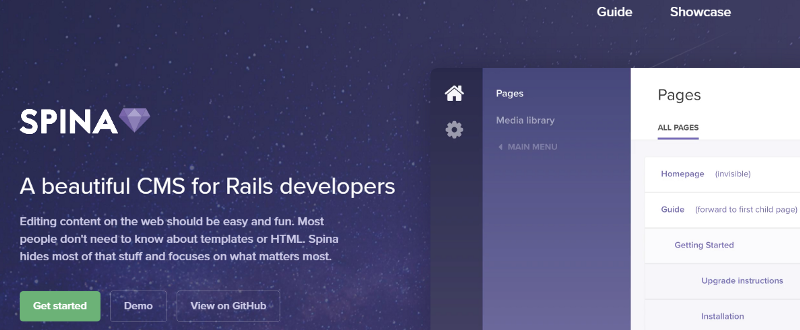Top 7 Ruby On Rails CMS Platforms for 2025
Last Updated on December 6, 2024
Quick Summary:
As you plan to have your website, you might hire a team of developers who make your website exciting and unique. However, this might turn out to be complicated, especially when you are seeking a small and straightforward web project. Instead, if you opt to go with a CMS, you will be able to make and deliver your website faster with minimal effort.
In this post, we are going to compile everything you need to know for choosing the right CMS for your project idea, along with introducing you to the top 7 Ruby on Rails CMS platforms.
With the help of a Content Management System (CMS), you can easily handle and manage your website’s content. The CMS gets the format of your content right. It controls the indexing, as well as aids effortless publishing options.
These essential features and functions of a Content Management System can be explained as under:
The CMS enables any of your old or existing content formats into the new electronic format of HTML or PDF before you upload it on your website. It helps to index your content so that you can quickly and speedily search for any keyword or attribute (e.g., date, etc.).
CMS enables prefix templates for your content publishing or modification. Some specific Content Management Systems also some other tools like template customization, multiple-language support, file management, and one-to-one marketing.
You might not be sure about what this kind of marketing means. But as I tell you that when you search for something and moments later, you find ads suggesting products or services relevant to your search. This phenomenon is one-to-one marketing, which is customized per user. It yields different results for different users.
Today, there is n number of CMS platforms available in the market, so it is tough for you to select the ideal one for you. Well, it primarily depends on your project needs. It will be of no use if you select a CMS that contains many features, whereas your project does not require them. You shall unnecessarily lay load on your system. So, you must first figure out what functions does your project needs in a CMS and then go for options of choosing it.
Here are some aspects that we think you should look over:
Anyone who interacts with your website panel or dashboard should be able to work with it efficiently. It’s not only the developer that interacts with your Content Management System, but also the members of your Digital Marketing team, Marketing team, Admin Panel, and more. So, choose a CMS that is easy to use for all.
As we mentioned earlier that you should choose a CMS with features that you need; otherwise, you will unnecessarily overload your system. Generally, if you need a CMS just for your blog, then there is no use in selecting a CMS with full features. This way, what ideally should have asked just a few minutes for publishing your content might take up a few hours of a tedious and unnecessary detour of your content and website.
Check on the flexibility of the CMS you choose for your project. Presently you may require minimum features, but in the future, you should keep a probability of expanding. Thus, select a CMS that is customizable in the future by adding new additional tools and functionality.
You might be thinking that this point is quite similar to the first point of consideration. But here, we are talking about your CMS should be such that your developers should be able to modify it when needed. Depending on your website and timely requirements, developers need to keep modifying some plugins to be updated. So, consult with your developers before you invest in any CMS.
The ultimate reason for hosting your website is to attract loads of traffic. Having a CMS should not cause a barrier in the primary purpose. See to it that your CMS can handle traffic well.
Are you looking for Rails developers to ease out your project complexities?
Then, why haven’t you contacted us yet? Want the best? Get the best! Contact us to hire Ruby on Rails developers!
When you want to build a custom website that inherits out-of-the-box themes and a unique UI, try and give Ruby on railS CMS platforms a chance to prove their excellence. You might not be satisfied with the tools and functions that other Content Management Platforms offer.
Bring a change for your users and your developers. This change is what the market needs at this point. We’ve compiled the best 7 Ruby on Rails CMS platforms that you should consider for your websites in 2025.

Your developers should be happy as you choose Alchemy Content Management System because they can customize any mere edits in the CMS with their excellent coding skills. Alchemy takes the base of Ruby on Rails 4.0 and offers multi-level caching along with internationalization and localization.
It supports working with the most common database, such as MySQL, SQLite, or PostgreSQL. The most significant advantage of using Alchemy CMS is that it is highly scalable, so as you want to prosper your business, the CMS will never be a barrier. Alchemy has excellent documentation and has a great approach.
Your website remains secure and robust with Alchemy CMS because it stands upright against attacks like XSS and CSRF. You may check out the excellence of this CMS here.
Features of Alchemy
Advantages of Alchemy
Disadvantages of Alchemy

Refinery Content Management System is an open-source and free RoR project. It comprises a list of extensive features like built-in editor galleries, calendars, search support, and much more.
You can combine this CMS with any other RoR application, and it has a hassle-free single field for content per page. Refinery CMS supports more than 30 language support.
It has a vibrant community of contributors and watchers on GitHub.
Features of Refinery
Advantages of Refinery
Disadvantages of Refinery
Unlike other Rails CMS, Fae goes beyond the bare necessities to provide authentication/authorization, a well-responsive user interface, and support for workflow. What sets Fae apart is its unique approach of generating models, controllers, and views within your application that inherit from its core classes. Its innovative design simplifies integration, requiring minimal coding effort. However, when the need arises to customize specific views or entire sections, it offers an easy way out in a developer-friendly way to make those adjustments instantly, making it a versatile choice for Rails developers.
Features of Fae
Advantages of Fae
Disadvantages of Fae
Build a high-performance Rails application with us!
Are you looking for dedicated Ruby on Rails developers with extraordinary problem-solving skills? Then, get in touch with Bacancy – The best Ruby on Rails development company and discuss your project requirements!

If you are keen to host a well-versed and interactive website without having the trouble of learning HTML or CSS, Spina CMS is the right choice for you. The easiest way to manage and publish your content is by using the Spina Content Management System.
Spina CMS supports Ruby on Rails 5+ versions. It is extendable and supports multiple languages.
Features of Spina
Advantages of Spina
Disadvantages of Spina

Browser Content Management System has a highly intuitive interface, is mobile responsive, is customizable, and has multi-level access. This Content Management System comes in with three user categories who can use it: editors, designers, and developers. With these separate modules, you get the ease of handling your website by assigning distributed work to your team.
Features like the CRUD interface, section-focused security, and advanced caching make it truly justifiable to hold the position in the top 7 best Ruby on Rails CMS platforms.
Features of Browser CMS
Advantages of Browser CMS
Disadvantages of Browser

The very first CMS developed for Rails was Radiant CMS. It was built in 2006 and now provides 200+ extensions to date. The main reason behind its popularity is Radiant CMS is highly extensible and accessible. Also, it’s very lightweight. The major drawback of Radiant CMS is that it hasn’t provided the latest version update for 5 years. Thus making it a bit outdated.
Features of Radiant CMS
Advantages of Radiant CMS
Disadvantages of Radiant CMS

Locomotive CMS – a commercial software available in both free and paid versions. Compare to the paid version of Locomotive CMS, the free version is more compatible with the Rails website providing better functionality. No doubt, you should go for Locomotive CMS when you want to design an easy and pragmatic site with a sharp interface.
Features of Locomotive CMS
Advantages of Locomotive CMS
Disadvantages of Locomotive CMS
As per our experience, we have curated the best list of Ruby on Rails Content Management System Platforms in the year 2025. We are hopeful that it will be useful to you and we are keen to hear more from you about your experience.
Sure, you might too want to spark the limelight on your custom website that uses a different CMS than the ordinary. Reach out to the best Ruby on Rails Development Company and aid the best assistance.
Here are the reasons to consider for using Ruby on Rails:
YES! Absolutely! Ruby on Rails is alive and competing at its best. You might want to think about your application at an architectural level before choosing RoR, as it advisable for heavy, scalable, and complex applications. But, claiming that Rails is dead, not at all! You have still got competition with RoR.
No. Ruby on Rails or Rails is not a CMS; rather it is a web app framework that works at the server-side and is based on MVC (model-view-controller) architecture. Do not confuse Ruby on Rails with Ruby. RoR/Rails is a web framework written in Ruby, that applies Ruby is language.
Your Success Is Guaranteed !
We accelerate the release of digital product and guaranteed their success
We Use Slack, Jira & GitHub for Accurate Deployment and Effective Communication.